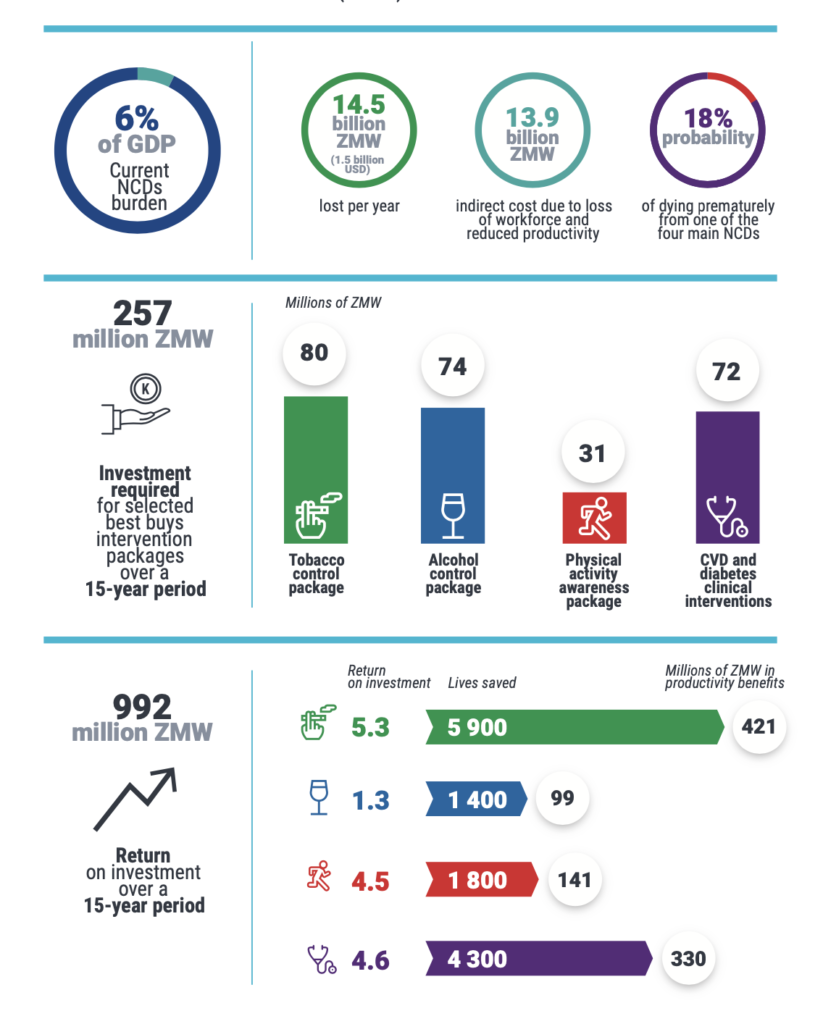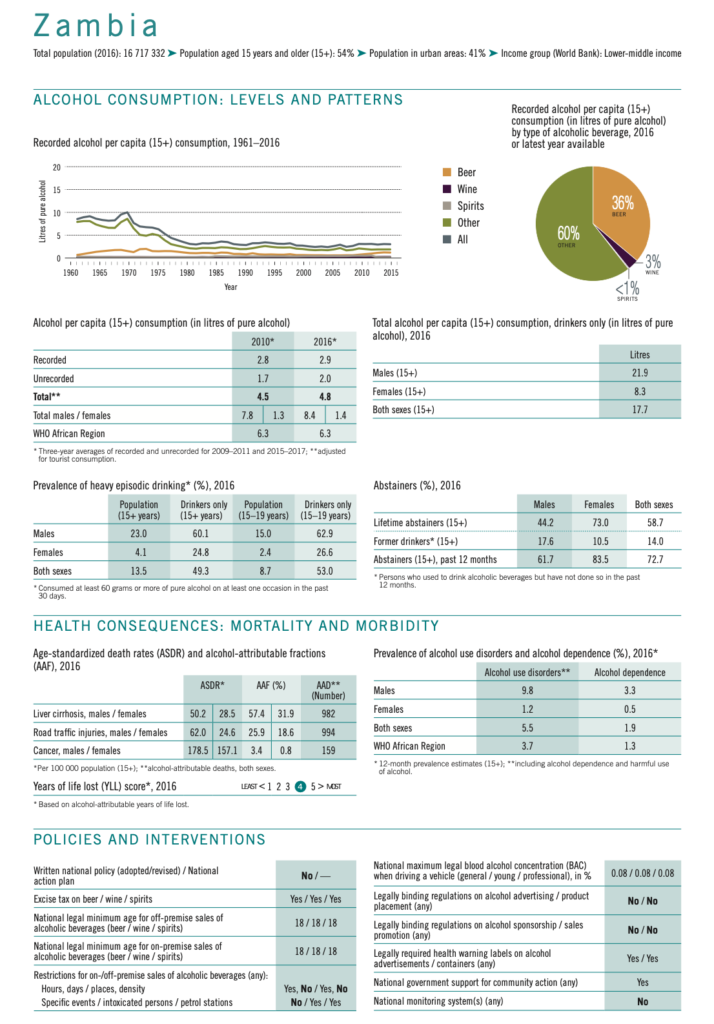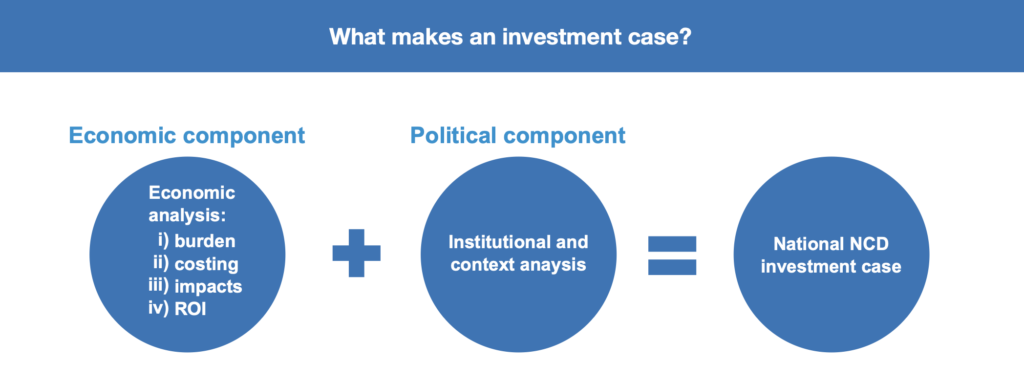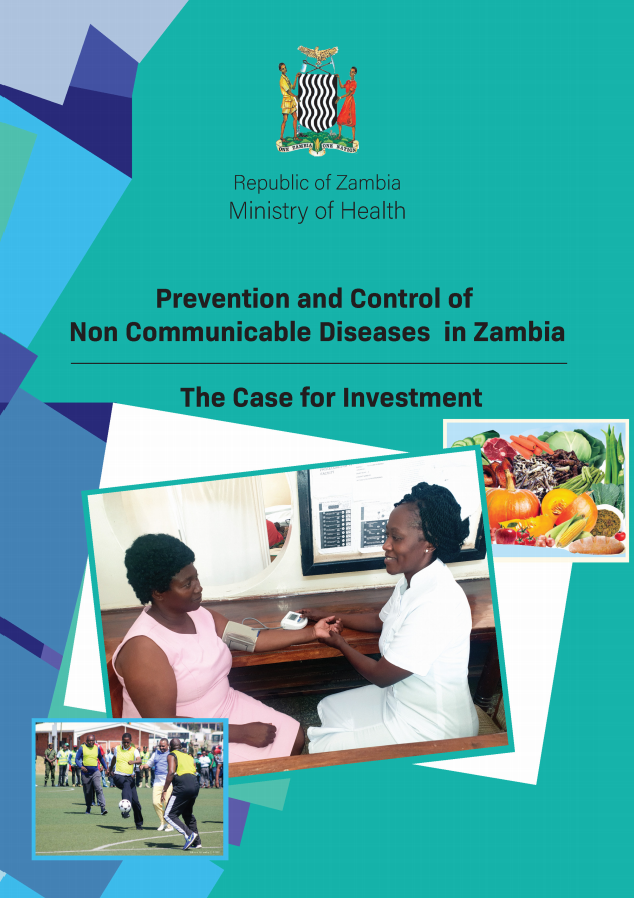NCDs and their risk factors exert a heavy toll on Zambian communities.
- NCDs cost the Zambian government 6% of its GDP every year.
- In 2016, NCDs were responsible for 29% of all deaths in the country, and of these 62% were premature.
- Over 90% of the economic burden in Zambia is due to economic productivity losses as workers get sick and die prematurely of the four main NCDs – cardiovascular disease (CVD), cancers, diabetes and Chronic Obstructive Pulmonary Disease(COPD) – fueled by risk factor such as tobacco and alcohol.
- This NCD burden can be reduced significantly by tackling the four main preventable risk factors – alcohol use, tobacco use, physical inactivity and unhealthy diet.

Clearly, the Zambian aspiration to achieve socioeconomic development and transform Zambia into a prosperous middle-income country by 2030 is threatened by the double burden of Communicable and Non-Communicable Diseases. Zambia has been recording an increase in morbidity and mortality due to NCDs, according to the WHO.
NCDs prevention and control in Zambia: The case for investment
NCD investment cases are national economic and political analyses of current and potential interventions to prevent and control NCDs. The aim is to define the costs of inaction or the status quo response, identify priority areas of action, and quantify the benefits of these actions – incorporating both economic and political perspectives of the specific country context to ensure adaptability and feasibility of the recommended policy interventions.
Investment cases are part of a UNDP-WHO Joint Programme to catalyze multisectoral action in Member States to reduce the burden of NCDs. The Joint Programme is part of the larger work of the UN Interagency Task Force on the Prevention and Control of NCDs.
This NCD Investment Case report for Zambia identifies 11 key evidence-based interventions that would deliver an economic Return On Investment (ROI) of 4:1 over 15 years for Zambia. These measures would lead to economic growth, generate revenue and reduce mortality and morbidity from NCDs in the country.
- Investing in all recommended intervention packages would save more than 13,420 lives and help avert more than 19,360 cases of stroke and Ischemic Heart Disease (IHD) over 15 years, providing Zambians an additional 362,885 healthy life years.
- A healthier workforce and reduced premature mortality would increase total GDP by 992 million ZMW (USD 104 million) over 15 years.
- Cost of implementing the recommended policy and clinical interventions over 15 years is less than one fifth of what the Zambian economy loses every year due to high prevalence of NCDs.
- Over 15 years, the gains from implementing each of the analysed intervention packages significantly exceed its costs: for the package of tobacco interventions the ROI is ZMW 5.3 per ZMW invested, for physical inactivity 4.5, for CVD primary care – 4.6, and for alcohol – 1.3, meaning all packages covered by the analysis are cost effective.
Alcohol harm and policy in Zambia – urgent need and huge potential for investment
The investment case analyzes the current economic burden from the main NCDs, estimates costs of interventions to prevent, reduce this NCD burden, estimates the impact of the interventions in terms of health and economic gains and conducts a return on investment (ROI) analysis to find cost-effectiveness.
In terms of alcohol control policy the investment case looked into three key interventions.
- Enforce restrictions on availability of retailed alcohol;
- Enforce restrictions on alcohol advertising; and
- Raise taxes on alcoholic beverages.
Zambia already has the foundation to implement these interventions. The country implemented the Liquor Licensing Act 2011, establishing rules for alcohol sales and purchasing. A National Alcohol Policy and Implementation Framework has been developed to address several key areas including coordination, prevention of alcohol harm, treatment of individuals affected and training for management of alcohol related problems, including enforcement related to the Act. In 2012, a civil society alliance called the Network Against Harmful Use of Alcohol (ZNAHUA) was formed and has contributed significantly to the formulation of this policy.
As the WHO Global Alcohol Status Report 2018 shows, alcohol harm places a heavy burden on people and communities in Zambia.
While the vast majority of Zambian adults live free from alcohol (more than 72%), those people who do consume alcohol, do so heavily and often in binge consumption patterns. More than 17 liters of pure alcohol per alcohol user per year is a staggering amount. The fact that almost 10% of Zambian men have an alcohol use disorder is a personal, community and national problem. Almost 50% of all alcohol users engage in heavy episodic alcohol use in Zambia. This places the country among those countries in the world with the most years of life lost due to alcohol.
Clearly, more can be done to improve alcohol policy development, such as raising alcohol taxation, improving alcohol availability rules, banning alcohol ads, sponsorship and promotions, and more.

In this context, the new investment case shows that investing in the alcohol policy best buy blue print has a 1.3 ROI. Which means for every 1 ZMW invested there is a gain of 1.3 ZMW, across 15 years. The alcohol control package can avert 1423 deaths and restore 232,020 healthy life years for Zambians. The alcohol package by far restores the highest amount of healthy life years among all recommended packages.
The ROI for the alcohol policy best buy solutions is likely an underestimation because the methodology of the current NCDs investment does not yet include all alcohol harms, for example those that go beyond non-communicable diseases.
Additionally raising alcohol taxes would provide the Zambian government a source of revenue. This revenue can then be invested into NCD prevention and control activities in Zambia by earmarking them for achieving Universal Health Coverage (UHC) and social spending. This way, Zambia could put itself on track to achieve its own 2030 vision of transformation into a prosperous middle-income country.
Raising tobacco and alcohol taxation would provide an important additional revenue stream for the government. There is a significant gap between the current tax rate on tobacco (37.3% of retail price) and the WHO recommendation (70%). This shows the potential in using health taxes to reduce the tobacco and alcohol burden, to promote healthy environments and to raise domestic resources for Zambia’s Vision 2030.
For further reading
More about investment cases
Specifically, in paragraph 24 they commit to:
Develop, as appropriate, a national investment case on the prevention and control of non-communicable diseases to raise awareness about the national public health burden caused by non-communicable diseases, health inequities, the relationship between non-communicable diseases, poverty, and social and economic development, the number of lives that could be saved and the return on investment”
Political declaration of the third high-level meeting of the General Assembly on the prevention and control of non-communicable diseases, 2018
Governments, such as in Zambia, are increasingly requesting the assistance of the United Nations (UN) and partners to quantify the national-level costs of treating NCDs, the costs of NCD burdens on the economy, the costs of interventions to prevent and control NCDs, and the return on investment (ROI) of those interventions.
Heads of State and Government have committed to develop national NCD investment cases in the 2018 ‘Political declaration of the third high-level meeting of the General Assembly on the prevention and control of non-communicable diseases.’
NCD investment cases are national economic and political analyses of current and potential interventions to prevent and control NCDs. The aim is to define the costs of inaction or the status quo response, identify priority areas of action, and quantify the benefits of these actions. Our case for investment incorporates both economic and political perspectives to ensure that the recommendations are made in the context of institutional capacities and economic and political environments.

The NCD investment case supports governments to identify and understand, scale-up and prioritize increased investments in NCD prevention and control. There are two major components of the investment case; an economic and a political economy component. They are quantitative and qualitative exercises respectively. A return on investment (ROI) analysis constitutes the economic component. It quantitatively evaluates costs of inaction (baseline or ‘business as usual’ scenario) and the potential returns to implementing a set of country-specific priority interventions.
